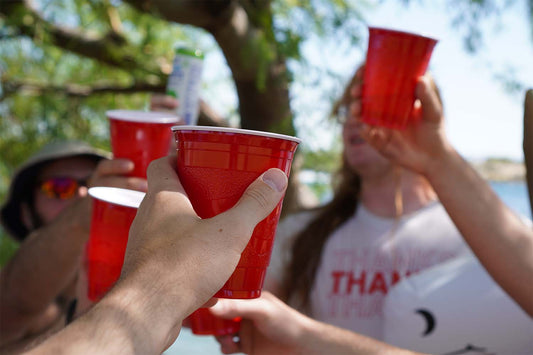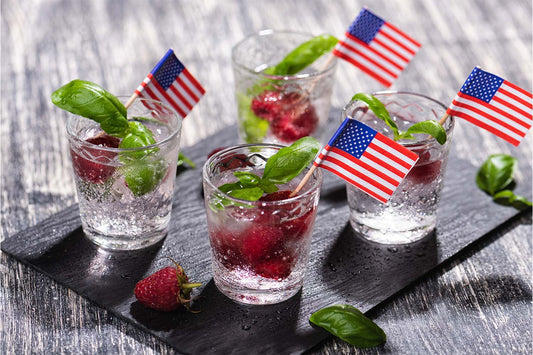No proper bar is complete without high-quality vermouth on the shelf. But for many home bartenders, information on vermouth is a bit elusive. Many don’t know what vermouth truly is, let alone how to pick one that is right for their needs at their home bar.
Vermouth is a historic drink, and it’s also incredibly delicious. There’s a reason so many classic cocktails contain this important spirit and why it has been enjoyed for centuries.
Today, we will go through everything you need to know about the spirit vermouth. By the end, you’ll have all the info you’ll need to add some delicious, quality vermouth to that liquor cabinet of yours. Let’s jump in.
What Is Vermouth?
First things first: You need to know the ins and outs of vermouth before you can understand how to pick one that fits your needs. So let’s have a quick “define our terms” moment.
Vermouth is a wine that is fortified with spirits and aromatized with botanicals. If that sounds like a fairly broad definition, that’s because it is. Vermouth is a diverse drink, and each company has its special recipes to make it delicious. Although many people think it’s a liqueur, it’s actually an aromatized wine.
The name “vermouth” comes from a French pronunciation of the German word for wormwood, aka wermut, a main ingredient in vermouth (and, interestingly, absinthe).
While most wines hover around 11% or 12% ABV, vermouths are fortified with distilled spirits, making their ABV higher, typically around 18% or 20%. So it is much lower in alcohol content than liquors like whiskey, tequila, or vodka, but it has more alcohol than a beer or wine.
What Is a Spirit?
Vermouth is considered a spirit. Many people will contest this, saying that it isn’t high enough in ABV, but, legally speaking, vermouth checks all the boxes to be considered a spirit. The Food and Agriculture Association of the United Nations defines what qualifies as a spirit, and vermouth makes the cut.
To qualify for the title of spirit, a drink has to have an alcohol content of at least 15% and be made by the process of distilling fruits, vegetables, or fermented products or by mixing a substance with another spirit.
Because vermouth is made by fortifying white wine with another spirit, it certainly lives up to the title of spirit.
How Is Vermouth Made?
We’ve already established that vermouth is made by fortifying wine (typically a white wine) with a spirit and aromatizing it with botanicals, but what exactly does that mean? And what does that process look like?
It has to be made with at least 75% wine to be considered vermouth. The wine is usually made from white grapes. The remaining piece of the puzzle is a mixture of sugar, botanicals, and alcohol. This is what gives vermouth its distinct flavor, and it’s also where various recipes differ.
Perhaps the most important ingredient in this signature spirit is an artemisia. An artemisia is a bitter plant or root which gives vermouth that characteristic bitterness.
The botanicals are also key when it comes to flavor. Botanicals are either made through maceration or distillation. Maceration is when the botanicals are soaked in water and alcohol, and distillation is when the alcohol is distilled through a basket of the botanicals. Vermouth crafters often put dozens of different botanicals in their recipes, making for an intense flavor experience.
The botanicals can be bitters, citrus, herbs, and spices. For the bitters, you might find:
- Wormwood
- Licorice root
- Cascarilla
- Cinchona bark
For the citrus, they might use the peels of:
- Oranges
- Lemons
- Limes
For the herbs, you could get:
- Juniper
- Lavender
- Chamomile
- Ginger
- Coriander
- Honeysuckle
- Sage
And you might get a warm, spiciness when you drink vermouth from:
- Cinnamon
- Cardamom
- Cloves
- Star anise
- Vanilla
- Nutmeg
Once the distilled blend of botanicals has made its happy way into the wine, all that’s left is to add another spirit to bring the ABV to the appropriate levels. Most of the time, the spirit used is brandy or a neutral spirit made from grapes, but some vermouth creators can get pretty experimental, using spirits made from various vegetables and their sugars.
Are There Different Types of Vermouth?
There are three primary types of vermouth that you need to know: sweet, dry, and blanc vermouth. There is a pretty big difference, and you don’t want to go substituting if you can avoid it. Putting the wrong vermouth in a cocktail recipe is a quick way to take away the authenticity of a cocktail.
Sweet Vermouth
Sweet vermouth is exactly what it sounds like: sweet. It has a high sugar content, with about 10% to 15% sugar. The sugar is added, so it doesn’t occur naturally in the fermentation process, but it makes for a delicious and sweet drink. The caramelized sugar tints the vermouth from clear to a soft red color, so sweet vermouth is often called red vermouth or rosso vermouth.
Sweet vermouth is the essential ingredient for a Manhattan. The sweet red varieties of vermouth take their origins in Italy, so this variety is sometimes called Italian vermouth.
Dry Vermouth
The second main type of vermouth is dry vermouth, sometimes known as French vermouth. Dry vermouth has a much lower sugar content than sweet vermouth, and it also tends to be less fruity and more herbal. Because of the lack of caramelized sugar, dry vermouth is a clear liquid.
Dry vermouth is the essential ingredient in a dry martini. Dry vermouths proudly take their heritage from France. They have much less added sugar than sweet vermouths and taste, well, dry.
Because there is no caramelized added sugar, dry vermouths don’t have that distinct color that sweet vermouths have. Dry vermouths tend to be clear, which helps create that elegant martini aesthetic.
Dry vermouths also tend to be a bit more herbal in their flavor profile, whereas sweet vermouths can be fruitier. But again, every producer of vermouth has their unique secret recipe, and you can find vermouth with pretty much any flavor profile you can think of.
Blanc Vermouth
Blanc vermouth is a bit of an in-between of the two mentioned above, sometimes also called bianco vermouth. Blanc is sweet white vermouth, so it is similar in look to dry vermouth, but it also has added sugar, so it has some tasting qualities similar to sweet vermouth.
The sugar isn’t caramelized in blanc vermouth, so it still maintains its clear look, but it’s still sweet to the taste.
Lesser-Known Vermouth Varieties
Though the three varieties of vermouth listed above are the most popular, they are not the only options. You might also find the following:
- Rosé vermouth
- Amber vermouth
A Brief History of Vermouth
Although vermouth was popularized in Europe, specifically Italy and France, it takes its early history from ancient China, believe it or not. Historical documents have surfaced that show that the earliest version of fortified wine came from the Neolithic period in China, about 8,000 years ago.
This archaic ancestor to vermouth was a wine that was fortified with botanicals that were intended to be healthy, like fruits, rice malt, and honey. Because of this, many people believe that the drink traveled its way down the famous Silk Road trade route, making its way to Europe, where it was later perfected. However, experts in vermouth believe that this was not the case.
Instead, fortified wines and vermouth likely developed in several different places around the world, all separate from each other. We see versions of it across the globe. There are resinated wines that come from ancient Iran and herbal wines that were created in Egypt.
But the version that became popularized as the vermouth we know and love today came from Turin, Italy, in 1786. A man by the name of Antonio Benedetto Carpano made a drink that he called “wermut,” which is the Germanic word for wormwood. By creating the fortified wine with wormwood and other healthy botanicals, he believed he had created a nice, healthy drink. It was marketed for health purposes, much like amaro was.
Carpano began to commercialize his drink, which later became known as vermouth, and it was wildly popular throughout the world. More and more producers of vermouth started to pop up, each with their own spin on the fortified wine. Today, there are dozens of vermouth brands out there.
An Apéritif Wine
Vermouth was originally intended to be an apéritif, a drink usually consumed before a meal to whet the appetite and prepare your body for a delicious — and potentially large — meal. It encourages your hunger and awakens your appetite.
Because apéritifs are meant to prepare you for a meal, they’re typically on the lower side of alcoholic content. Too much alcohol can dull your senses, preventing you from tasting the fullness of the meal. The same thing goes for sugar, too much of which can corrupt your sense of taste.
So dry vermouth, in particular, was drunk by itself (not in a cocktail) as a delicious apéritif. Think of apéritifs as a happy hour, but way fancier. They’re often drunk with small hors d’oeurvres, savory snacks, or appetizers.
Although the idea of apéritifs had been around since the 5th century, they didn’t become an important part of European eating and drinking culture until the 18th century. Vermouth was actually an important player in the popularization of apéritifs as a whole. It helped spur the tradition into common practice, and it’s still popular in places like Spain and Portugal today.
Vermouth in Cocktails
In 1853, vermouth found its way over to the United States during the World’s Fair in New York. It wasn’t a hit right away, but after another decade, the culture had changed. Cocktails were becoming a popular way to drink in public while still looking chic and classy.
With the rise of cocktails, vermouth found its home in American drinking culture. Dozens of cocktails became incredibly popular that utilized vermouth. Many of them are still popular today, including the Rob Roy, the Manhattan, and the Negroni.
Important Vermouth Cocktails You Need to Know
In the United States today, vermouth is rarely drunk on its own. Now it’s a staple ingredient in dozens of famous cocktails. If you’re reading this article, you probably want to make a few of them, so here are a few of the essential vermouth cocktails you need to know.
The Martini
You probably know the martini for being James Bond’s drink of choice and that he prefers it shaken, not stirred. Well, this cocktail has been around in some form or another since 1882. It’s taken several evolutions throughout that time, and everybody prefers it differently, but what makes a martini is the presence of dry vermouth and gin.
Every bartender will make their martini slightly different. But the drink is normally made with a 1:3, 1:2, or 1:1 ratio of gin to extra dry vermouth. It can be garnished with a citrus peel or an olive.
The Negroni
The Negroni was famously invented by Count Camillo Negroni in Florence in the 1920s. The Count ordered an americano but asked for the club soda to be replaced with gin.
This makes for a drink with equal parts gin, Campari, and sweet vermouth. Garnish with an orange peel (or even a slice of orange), and you have an absolutely delicious classic cocktail. There have been countless variations on this classic.
The Manhattan
Another cocktail that utilizes vermouth is the Manhattan. Every bartender will tell you a different story about how this famous cocktail came to be, but most of them will point to the 1880s as its starting point.
The classic Manhattan recipe is two parts rye whiskey and one part sweet vermouth with two dashes of Angostura bitters. And don’t forget to garnish with a Maraschino cherry (yes, it has to be Maraschino).
And if you want to skip the vermouth in this recipe? Try swapping it out for our Spiced Cherry flavor.
How To Pick Out Your Vermouth
When picking out your vermouth, the most important thing is that you know what you’re getting it for. If you’re making a cocktail, we suggest avoiding substitutions as much as possible. A Manhattan with dry vermouth instead of sweet just wouldn’t taste quite right, and some bartenders would call a Manhattan without dry vermouth straight-up criminal.
If you’re looking to drink your vermouth straight and use it as an apéritif, dry vermouth is going to suit your needs better. It has less sugar, so it will get your appetite going better than sweet vermouth will.
The Legendary Vermouth
Vermouth is nothing short of a historic spirit. It has been a trendsetter since the time of its invention, pushing movements like apéritifs and cocktail culture. And now you know everything you need to know about vermouth, its history, and its various types.
And if you’re looking to learn more about apéritifs and have more apéritif options at your fingertips, visit Haus for some delicious, clean, and quality options.
Sources
6 Classic Vermouth Cocktails That Deserve Your Respect | Tales of the Cocktail Foundation
Buying Guide for Vermouth | ABC Virginia
Council Regulation No 1576/89 | Food and Agriculture Association of the United Nations
Vermouth: The Spirit That Started It All | Culinary Historians of NY




